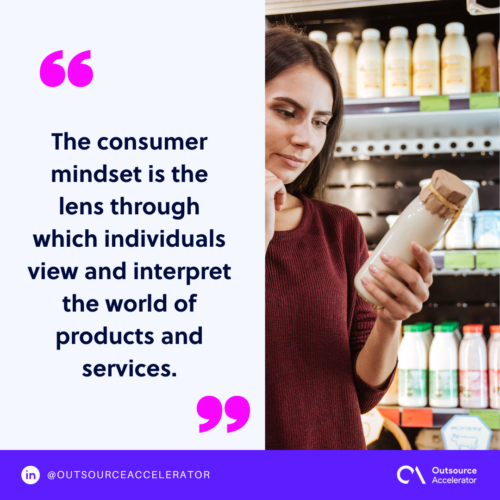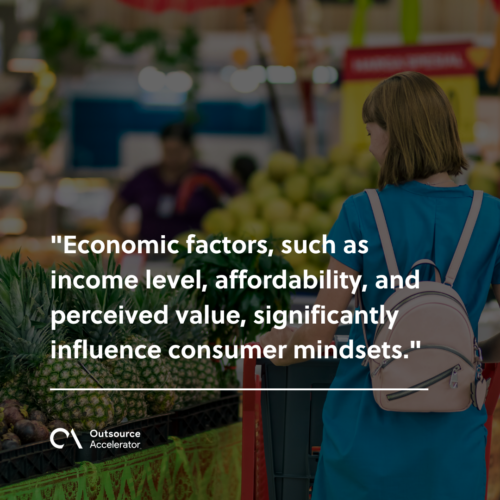Uncovering the consumer mindset

The consumer mindset refers to the attitudes, beliefs, and perceptions that influence a consumer’s decision-making process.
Changing consumer attitudes is constant. This is especially true in the age where customers consume volumes of information online. In fact, 92% of customers who started shopping online years ago have made it a habit.
With this trend comes the need to constantly understand the behavior of consumers.
In this article, we will delve into the intricacies of the consumer mindset and provide insights into adapting to the consumer’s mindset.
What is consumer mindset?
At its core, the consumer mindset is the lens through which individuals view and interpret the world of products and services. It encompasses their preferences, desires, and expectations when engaging with brands.
Understanding the intricacies of the consumer mindset allows businesses to align their offerings with the needs and wants of their target audience. This results in increased brand loyalty.

Importance of understanding consumer mindsets
Recognizing the importance of consumer mindsets is crucial in establishing a strong customer base and increasing their lifetime value.
- Reinforcing positive beliefs. A consumer mindset helps firms reinforce positive impressions about their products and services.
- Building credibility. By thinking like their consumers, companies can gain their patrons’ trust, which further helps build their credibility.
- Creating optimal experiences. Understanding the consumer mindset allows businesses to create optimal and personalized customer experiences.
Factors that affect consumer mindset
The consumer mindset is influenced by various factors that shape individuals’ attitudes, behaviors, and purchasing decisions.
Let’s explore some of the key factors:
Perception
Perception refers to how individuals interpret and make sense of the information presented to them visually.
Product quality, brand reputation, and customer reviews influence consumers’ perceptions and decision-making processes.
Motivation
Motivation is a driving force behind consumer behavior. It determines why individuals choose to engage with a particular brand or make a purchase.
Maslow’s hierarchy of needs is commonly used to determine a consumer’s behavior. Marketers might also consider why customers say ‘no’ or lose their motivation to get a product.
Understanding the underlying motivations of consumers can help businesses offer relevant incentives that align with their needs and desires.
Social factors
Social factors heavily impact consumer mindsets, including cultural norms, social influences, and peer recommendations.
People are often influenced by their friends, family, and societal trends when purchasing. Through this, various forms of marketing, such as word-of-mouth and influencer marketing, are deemed effective.
By understanding these social dynamics, businesses can tap into the power of social proof and leverage influencers to shape consumer mindsets positively towards their products or services.
Environmental factors
Environmental factors, such as the physical surroundings and situational context, also play a role in shaping the consumer mindset.
Whether online or physical, clients are most attracted to stores with presentable and functional tools, navigation, and other aspects affecting their experience.
Economic factors
Economic factors, such as income level, affordability, and perceived value, significantly influence consumer mindsets.
It’s natural for consumers to veer away from products or services that may be beyond their budget. At the same time, some customers might save them for later when their financial conditions get better.
Considering these economic factors allows stores to price their products competitively and offer flexible payment options to cater to diverse customer segments.

Modern trends that shape consumer mindsets
Consumer mindsets are not static; they evolve and adapt alongside societal trends.
Businesses must be aware of and responsive to the modern trends that affect consumer mindsets. Here are some of these current trends.
Consciousness of health and wellness
There has been a significant shift towards health and wellness in recent years.
Consumers are increasingly conscious of their physical and mental well-being, which is reflected in their buying behavior. They seek products and services that support their health and welfare.
Businesses that align their offerings with this trend can tap into a growing market by showcasing how their products contribute to overall well-being.
Contribution to the community
Consumers are more socially conscious than ever. They are drawn to brands that actively practice their social values and positively impact the community.
By aligning brand values with social initiatives, organizations can resonate with consumers who prioritize making a difference through purchasing decisions.
Hassle-free experience
Consumers value convenience and efficiency, especially when transacting online. They seek hassle-free experiences throughout their customer journey.
Companies prioritizing process streamlining and seamless online shopping experiences can gain a competitive edge by catering to this consumer mindset.
Adapting to the consumer’s mindset
Understanding the consumer mindset is crucial to thrive in a competitive marketplace.
Companies can tailor their marketing strategies to engage with their target audience by unveiling the complexities of consumer attitudes, motivations, and perceptions.
Adapting to the ever-evolving consumer mindset enables businesses to build long-lasting relationships, drive conversions, and ultimately succeed in outranking their competitors.
Here are some strategies for adapting to the consumer’s mindset
- Conduct thorough market research to gain insights into your target audience’s preferences, needs, and pain points.
- Segment your audience in various categories so you can deliver targeted messages that speak to their mindset.
- Stay updated on emerging trends and adapt your offerings to meet changing consumer expectations.
- Continuously monitor and analyze consumer feedback and data to refine your strategies
Make sure you invest the time and effort to truly understand and connect with your target audience and watch your brand soar to new heights.







 Independent
Independent




